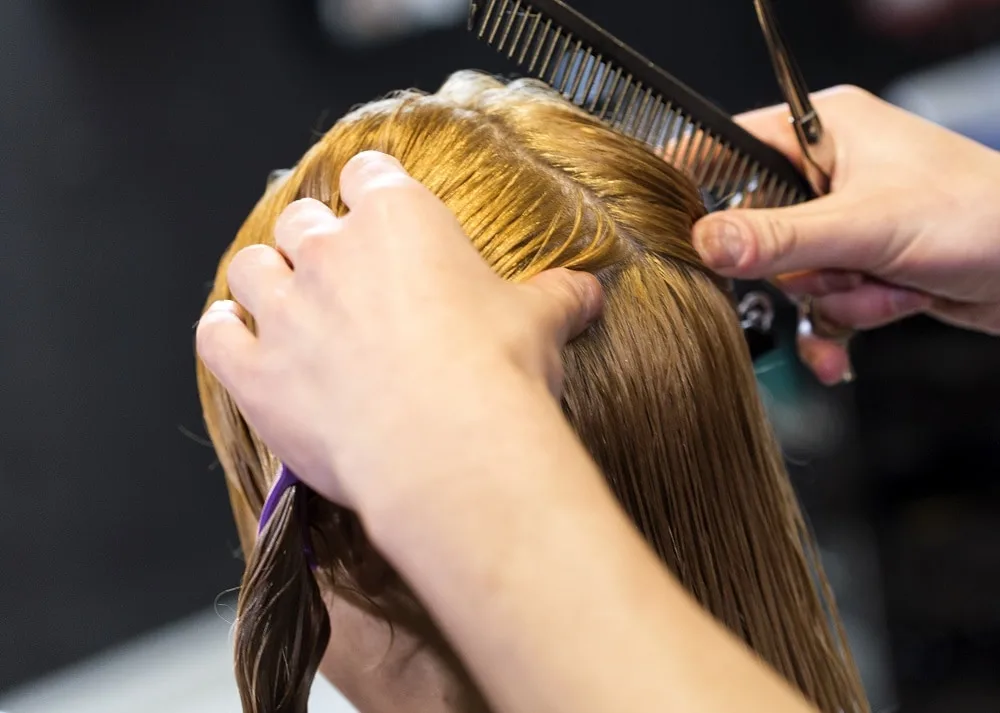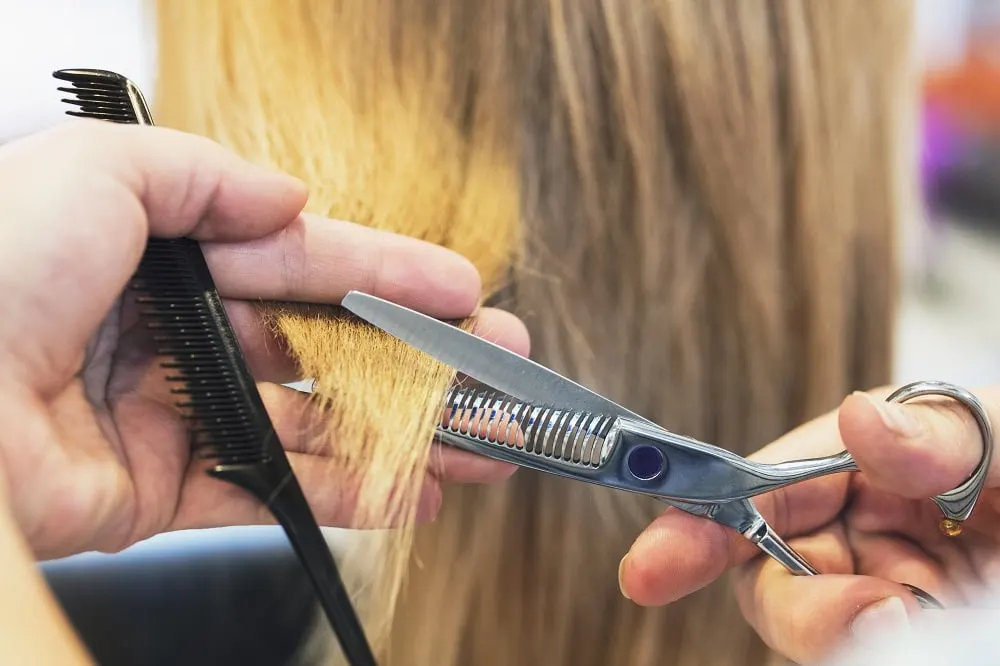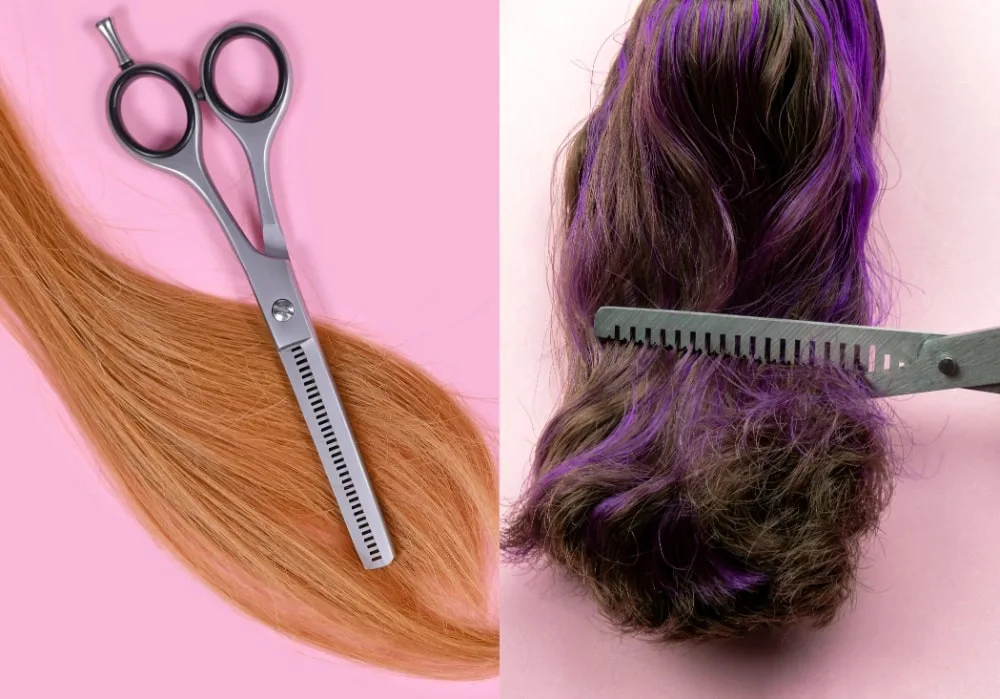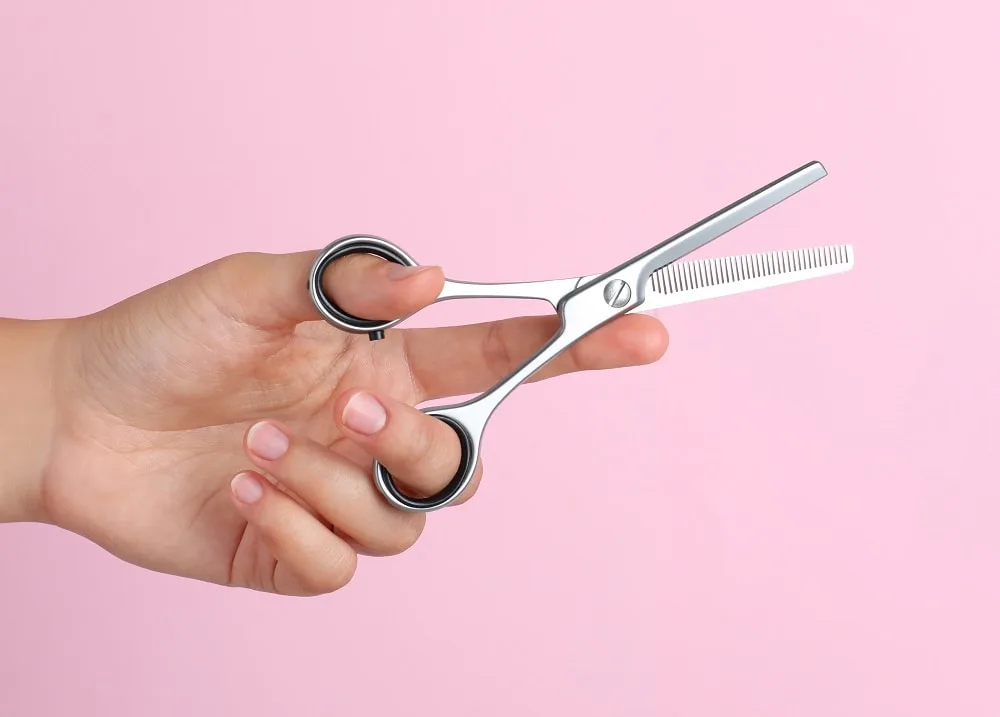Many of the hottest hair trends today need a bit more than a regular scissor that can only make a blunt cut. That’s where the versatility of thinning shears comes into play for the top stylists.
In addition, thinning shears can provide a bonus to a haircut, so that will be easier to maintain when shooting for a precise look. These shears can be overwhelming by sight, but here’s how to use thinning shears for hair in 5 simple steps so you can cut like the best in the field.
What Are Thinning Shears?

Thinning shears are in the professional scissor family and can be used on women or men. One side of the blades looks like regular scissors, while the other has sharp teeth resembling a mini comb.
The purpose of thinning shears is to thin out sections of hair to capture a specific style or blend. In addition, these shears can eliminate harsh lines, fade heavy cutting lines, and reduce an overabundance of hair in sections.
However, it’s important to remember that thinning shears aren’t for shaping but to give better management to the shape of a cut. The industry has dubbed this specific shear as the ‘decorating’ shear.
Another way to look at the true purpose of thinning scissors is that it’s like adding ‘the cherry on top’ of a great haircut.
Are Thinning Shears and Texturizing Shears the Same Thing?

Technically, no. Thinning shears and texturizing shears are not the same things, but they are incredibly similar if we’re being accurate. Texturizing shears may look like thinning shears, but if you look closely, the teeth on the comb side of the arms are a different size.
Although in some circles, blending shears is known as the same as thinning and texturizing shears, again, the teeth are different. Don’t worry; we’ll dive deeper into the purpose of other teeth sizes later.
What Do Thinning Shears Do to Your Hair?
Thinning shears are excellent in providing a sleeker look to a haircut. They are great for heads with too much hair when trying to achieve a specific style.
For example, if you have thick or curly hair that sticks out on the sides, thinning shears can remove the excess weight without removing the length to make the hair more uniform.
How To Use Thinning Shears for Hair
Using thinning shears takes a delicate touch. Be sure not to go in and hack at the hair because you’ll end up with a hatchet job. Working in small sections is ideal when getting the feel of thinning shears.
Make sure you have the right shears needed for the job, and whatever you do, don’t use shears with a broken tooth. Here’s a step-by-step on how to use thinning shears.
Step 1: Dry and Comb Hair Thoroughly
Thinning shears work best on dry hair since you can see the difference in real time. So, make sure hair is dried completely and combed thoroughly to ensure there are no knots or clumps before getting started. Tangles can cause a misjudgment in where your hair needs thinning or blending.
Step 2: Separate Hair into Sections

Divide your hair into sections so it doesn’t get too complicated on where you plan on cutting. Within those divided sections, you will break the strands into smaller sections.
It’s best to remember that working in smaller areas with thinning shears will give you more control over removing excess weight. Also, if you are texturizing, it will allow you to get in there without removing too much at once.
Step 3: Begin with Small Sections and Start Near the Ends
If you haven’t caught on yet, small sections is the theme here when it comes to using thinning shears successfully. Take your first small section, running your finger through it to ensure it doesn’t tangle.
Next, you will pull the hair taunt since you will be focusing on the ends. Do not start high on the shaft since there’s a great possibility you will remove too much weight.
Step 4: Angle Your Thinning Shears and Cut Through Hair

Once the section of hair is ready for cutting, angle your thinning shears and cut. You can use the teeth to pull down the loose hairs. Using a comb to remove all the cut strands is a good idea before taking another chomp at the same section.
If the area needs a bit more taken off, move up slightly from the first cut. If it needs to be blended more, move slightly down towards the ends to make the next cut. Don’t go overboard.
Step 5: Repeat for All Desired Sections of Hair
Once you’ve thinned each section, you may see areas needing a little more removed. Be sure to move your hair around and run your fingers through it to confirm since looks can be deceiving. If the area still feels too heavy, resection the area and repeat the process to achieve your desired look.
Are There Different Types of Thinning Shears?

There are several types of thinning sheers for different results. The best way to remember is that the more teeth, the less hair removed. Conversely, the fewer teeth, the more hair is removed. This rule of thumb will help you pick the right shears for the job at hand.
20 to 30 Teeth Thinning Shears
Picking shears between 20 to 30 teeth are for texturizing the hair. These shears will help in giving visual texture to the strands so it has a breezy look.
These shears are perfect for the bob or layers to remove the sharp step effect that regular scissors can leave behind. It provides a more whimsical blend that has personality and style. It resembles the look of a point cut process.
6 to 12 Teeth & 30 to 40 Teeth Thinning Shears
Regarding 6 to 12 & 30 to 40 teeth, it can be a bit confusing when following the rule above. However, hopefully, this description helps simplify it for you. The fewer teeth, the more hair will be removed, which is ideal for intense hair.
These shears are great for thinning hair and removing the heavy weight of thick hair individuals without leaving holes. It’s been seen that double teeth shears can remove just as much weight. So, for example, using 30 teeth with a 6 notch will significantly remove excess hair.
14 to 20 Teeth Thinning Shears
Shears that range from 14 to 20 are perfect for blending sharp edges and blunt cuts. This range is ideal for most hair types trying to get a soft edge. In addition, these teeth are the perfect finishing shear to make hair more manageable and effortless.
Use these shears when you desire a wash, dry, and go style, as opposed to a texturized style that might need extra effort to achieve a specific style.
What To Consider When Using Thinning Shears for Hair

Thinning, texturizing, and blending shears are fantastic when used correctly. However, not every hair type will benefit from using thinning sheers. Some hair textures will have a more significant benefit with a thinning shear than others, while some hair types should avoid the shears altogether.
Type of Hair
Let’s take a deeper dive into the different hair types because not everyone should use thinning shears on their hair.
The four hair types:
- Straight
- Wavy
- Curly
- Kinky
The thickness of your hair is what matters when it comes to thinning shears. Thin hair should avoid shears with any number of teeth. There are much better ways to blend with a point-cutting technique when your hair is thin. Now, thick straight hair is a great candidate for thinning shears.
As you move into a natural texture hair, the rules on shears change a bit. Wavy hair can benefit from shears when achieving a softer edge in the style.
However, more caution must be used when we move into curly hair options. Using a blending and texturing shear will give shape and remove some weight. Nevertheless, 5 notch teeth can remove too much weight, leaving holes behind.
As for the tightest kinky curl type, the best bet is to avoid all thinning shears unless you have experience in the field.
Just like thin hair, shears will remove too much of the corkscrew hair. In addition, there are better techniques that will shape and blend your hair.
What Type of Thinning Shears Are You Using?
So, now let’s look at the type of thinning shears you should use on each hair type.
Straight: Any type of sheer can be used on this hair type if it’s a thick head of hair. Blending shears will give soft edges, while thinning shears will reduce the heaviness. Texturizing shears are perfect for increasing a particular style.
Wavy: Just like straight hair, wavy hair can handle different types of shears. Soft waves can use some texturizing to enhance the contour of each curve. Thick hair may need a bit of weight lifted with a thinning shear, while wavy hair can undoubtedly benefit from the blending shear.
Curly: If you dare to use any shear on curly hair, make sure the thinning scissor are not ones with a low number of teeth. Professionals have significant experience in how to maneuver blending and texturizing shears, but if you’re a novice, use caution and work with small sections.
Kinky: It’s recommended to avoid all shears unless you have experience.
How Should You Hold Thinning Shears?

The grip of holding thinning shears is just like how to professionally hold scissors. This holding technique is the first lesson when learning to cut hair precisely. The same accuracy is needed when handling shears.
Hold shears with thumb and middle or ring finger. This procedure is known as the western grip. It allows your index finger to help control the blades like an anchor of support.
Be sure your fingers fit into the holes securely because if they are too big or too small, you won’t be able to hold the shears properly to get an accurate cut.
How Often Should You Use Thinning Shears on Your Hair?
Using thinning shears should be done sparingly where needed. For example, it’s suggested that trimming your hair should be done approximately every six weeks.
During that time, you may be able to do a light touch-up with the thinning shears. However, it might be much more beneficial to wait until every other trim before diving in again to clear out some weight.
Can You Overuse Thinning Shears on Your Hair?
Thinning shears can certainly be overused. Haven’t you ever heard about too much of a good thing? It always has the opportunity of going bad. It’s the same regarding thinning, blending, and texturizing shears.
Using any shear too often can cause damage to the hair. It can cause the hair to grow in all wrong. You might end up with a heavy section and a thin section.
Also, overusing shears can cause breakage or, worse, unwanted thinning. So, be aware of how often you use thinning shears and how much removal you do while using them.
What Are Some Alternatives to Thinning Shears?

There are alternatives to using thinning shears when it comes to getting a sleek or lightweight feel to your hair. One non-cutting option is to dry your hair while using a paddle brush. However, this process won’t work for the curler hair types. So, let’s take a look at three cutting options to try instead of using thinning shears.
Notching: Used on shorter hairstyles, this technique is perfect for blending and texturizing ends. It is done at a steep angle to thin out the ends and keep the hair from looking wide at the tips.
Point Cut: Perfect for hair with layers because this cut will thin out sections around the head. It’s similar to the notching process since it only focuses on the end of the hair. The angle is small, but the cut is more profound than what is traditionally used when notching.
Slithering: An excellent option for long, wavy, or curly hair is to take smaller sections and go on a smaller angle starting from the top of the shaft and gliding to the ends.
Final Thoughts
There you have it! Cutting scissors can provide the desired length, but sometimes you might need to use some thinning shears to obtain that weight, blend, and texture you want.
Now you know how to use thinning shears for hair in 5 simple steps. You also know what to avoid when it comes to using thinning shears, including avoiding any shears with one broken tooth.
It’s fun to experiment with your hair to achieve that perfect, fresh style, but remember to use shears conservatively to prevent damage to your strands. When it comes to thinning shears, a little can go a long way.
